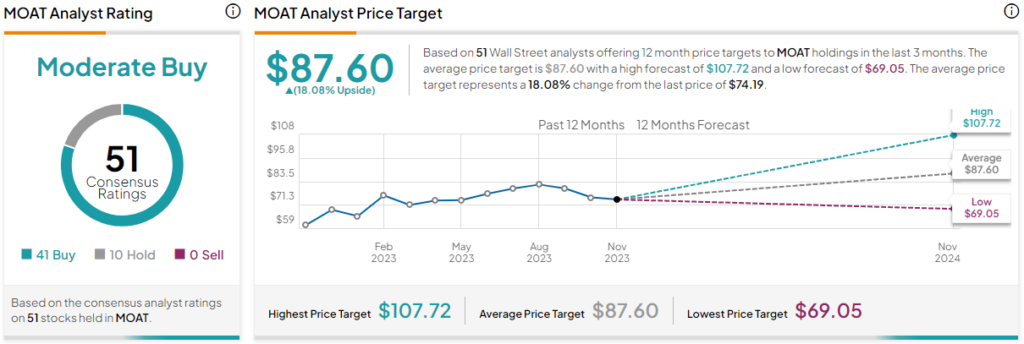The VanEck Morningstar Wide Moat ETF (BATS:MOAT) is a differentiated ETF with a unique focus: it invests in the stocks of businesses with wide moats (competitive advantages). I’m bullish on MOAT based on its sound strategy and its excellent track record of long-term outperformance.
What is the MOAT ETF’s Strategy?
VanEck states that MOAT invests in an index of “attractively priced companies with sustainable competitive advantages according to Morningstar’s equity research team.”
What is a Moat?
In business terms, a moat is a durable competitive advantage that enables a company to preserve its market share and fend off competition. The companies that MOAT invests in are expected to maintain these competitive advantages for 20 years into the future or more.
Factors that can lead to a wide moat include brand power, network effects, regulatory protection, intellectual property, and more.
An example of a business with a wide moat would be a company in the defense industry. Defense companies must regularly navigate through considerable regulatory hurdles and meet the specifications of governments and militaries, which is no easy task. Their products require significant technological expertise and upfront investment to create. Furthermore, their customers are conservative and risk-averse. They aren’t going to give their business to a new, fly-by-night competitor, giving the incumbents in the field a considerable moat.
While not an example from the public markets, another example of a moat effect might include the network effects enjoyed by a social network like X (formerly Twitter). Quite a few new entrants (Bluesky, Mammoth, and even Meta Platforms’ (NASDAQ:META) Threads) have emerged and tried to disrupt X’s business with similar models.
While some, like Threads, generated some initial buzz, none have been able to really overtake X because that’s where the users already are and where much of the conversation online is happening. Therefore, that’s where users want to be, illustrating the power of network effects.
MOAT’s Holdings
Altogether, MOAT owns 50 stocks, and its top 10 holdings account for just 27.1% of the fund, meaning that there is little concern about concentration risk here.
So, what types of companies does MOAT invest in? Below, you can check out an overview of MOAT’s top 10 holdings using TipRanks’ holdings tool.

Top holdings like Alphabet (NASDAQ:GOOGL) and Intercontinental Exchange (NYSE:ICE) are good examples of businesses with wide moats.
Alphabet has built a wide moat for itself because Google has become the go-to search engine that most people use any time they have a question or need to look something up. People are so used to using Google that the word “Google” has now become a verb — “I’ll Google it.”
Because of this ubiquity, it’s difficult for a new search engine to come in and take significant market share from Google. Google has been the leading search engine for many years and no one has come close to seriously threatening its market dominance.
In October, Google had 91.6% of the market share in the global search market. Even Bing, which is backed by the financial heft of Microsoft (NASDAQ:MSFT), has found it difficult to make headway against Google. Bing had just 3.1% share of the worldwide search market in October.
Intercontinental Exchange, the parent company of the New York Stock Exchange (not to mention several other exchanges and markets), is another good example of a business with a considerable moat.
The New York Stock Exchange has been around for over 230 years, and it is trusted by both companies and investors. It is the largest stock exchange in the world by market capitalization. Because of this, this is one of the premium destinations for companies to list their stocks. Nasdaq (NASDAQ:NDAQ) is, of course, a competitor to the NYSE, but you could say that both businesses have great moats.
In turn, investors want to invest in stocks listed on the NYSE because they know that this is where many of the world’s top companies are. It would take many years and a considerable amount of capital to set up a brand-new exchange that could realistically compete with the NYSE.
MOAT’s Long-Term Outperformance
It turns out that investing in businesses with wide moats is a pretty effective investing strategy, and the results bear this out. As of October 31, MOAT has generated a three-year annualized return of 12.2%. Further out, it has a five-year annualized return of 11.9% and a 10-year annualized return of 11.6%.
Furthermore, since its inception in 2012, MOAT has managed to generate a stellar 13.1% annualized return.
These returns compare favorably to the broader market. For comparison, as of October 31, the Vanguard S&P 500 ETF (NYSEARCA:VOO) has generated annualized returns of 10.3% over the past three years, 11.0% over the past five years, and 11.1% over the past 10 years. As you can see, MOAT has outperformed the S&P 500 over each time frame, making it one of the rare and laudable ETFs that can say that it consistently beats the market over a long time horizon.
Expense Ratio
MOAT’s expense ratio of 0.46% means that an investor allocating $10,000 into the fund will pay $46 in year one of investing. Assuming that the fund returns 5% per year going forward and maintains its current expense ratio, this same investor would pay $579 in fees over the course of 10 years.
While this is a bit expensive, MOAT is worth paying a premium for, as it justifies this fee with a market-beating performance over the past several years. There are also many ETFs with much higher expense ratios than this that don’t come close to matching MOAT’s long-term performance.
Is MOAT Stock a Buy, According to Analysts?
Turning to Wall Street, MOAT earns a Moderate Buy consensus rating based on 41 Buys, 10 Holds, and zero Sell ratings assigned in the past three months. The average MOAT stock price target of $87.60 implies 18.1% upside potential.

The Takeaway: Invest in Businesses with Wide Moats
In conclusion, it’s hard to argue with the strategy of investing in businesses with strong and durable competitive advantages. MOAT’s impeccable long-term results show that investing in this strategy has generated market-beating returns for investors over time. MOAT owns a portfolio of great companies that should continue to reap the rewards of their strong competitive advantages over time, so I’m bullish on this top-notch ETF, going forward.
















